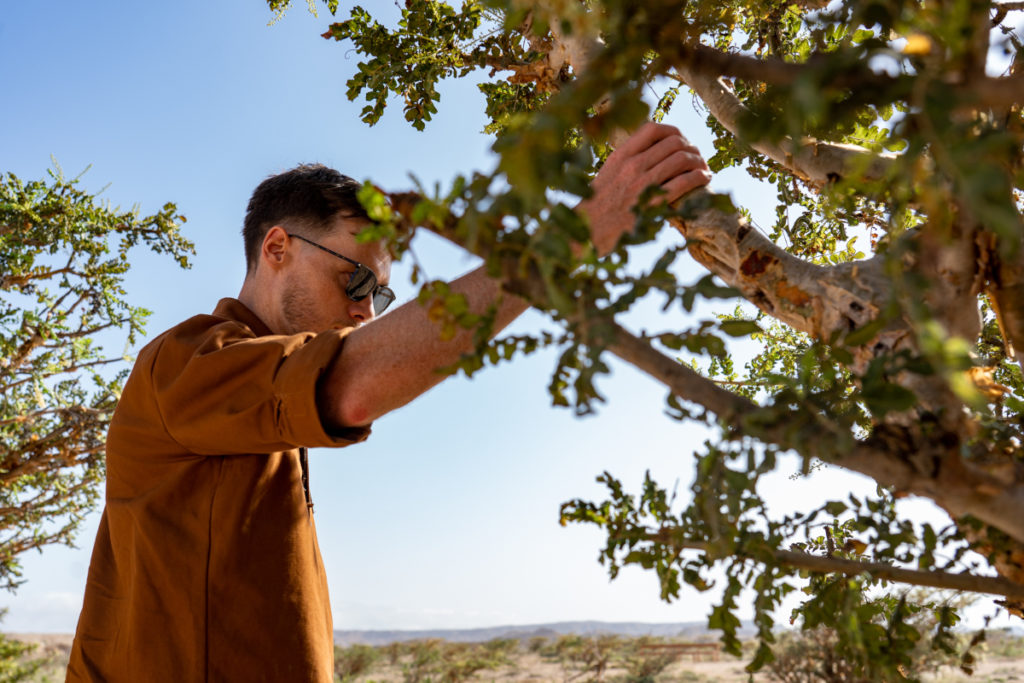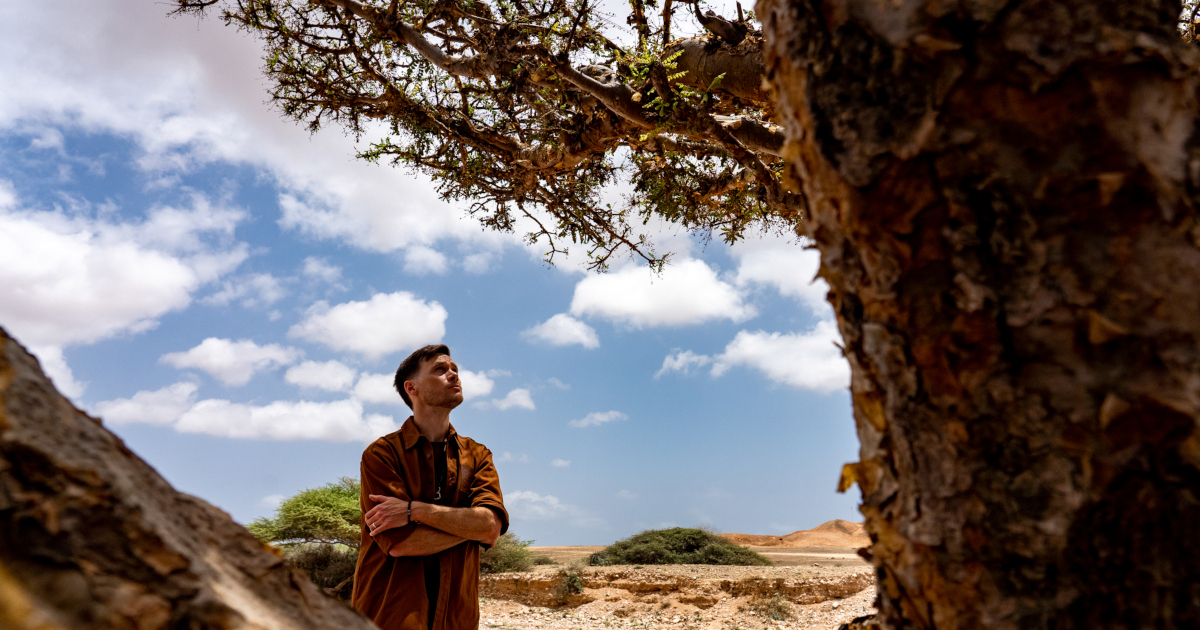Cette publication est également disponible en :
Français
Editorial partnership
In 2022, Amouage signed a partnership with Oman’s Ministry of Heritage and Tourism to relaunch the frankincense industry in the sultanate. This initiative follows on from the inscription of the Land of Frankincense on the UNESCO World Heritage List in 2000. Renaud Salmon, Chief Creative Officer of the Omani fragrance house, takes up the story. Interview.
Why did you feel it was important to launch a new frankincense industry in Oman?
The last few years have seen rising enthusiasm in the perfume industry for talking about natural ingredients with a measure of transparency, including for flowers, woods and some resins. But frankincense didn’t seem to be part of the conversation. It is, however, a key ingredient for Amouage fragrances and for the Sultanate of Oman. Not only as an ingredient, but also as a tree that is historically, culturally and economically important. Historically, it always generated a great deal of business centering on the raw material, involving traders and numerous intermediaries. But the fact that the resin is passed from hand to hand makes it particularly complicated to ensure frankincense’s traceability. Paradoxically, the best quality is supposedly found in Oman, but in reality there’s very little on the market. Even here.
So, where does today’s Omani frankincense come from?
It is harvested throughout the Dhofar region, in the south of the country. In 2000, four sites in the region corresponding to the historical Land of Frankincense were added to UNESCO’s World Heritage List. The Incense Route for the precious resin stretched from India, China and Mesopotamia at one end, before crossing Yemen from the Salalah region, then entering Saudi Arabia, then heading back up to Alexandria and Europe.
Why did you choose Wadi Dawkah to relaunch the Omani frankincense industry?
Wadi Dawkah is special thanks to its location on the Dhofar plateau, between desert aridity and monsoon humidity, which means it benefits from climate conditions that are potentially ideal for growing frankincense trees. These trees have been growing wild in the wadi for a very long time. The goal of the project launched by Amouage, in partnership with Oman’s Ministry of Heritage and Tourism, is to produce and harvest frankincense for perfumery across the site’s handful of square kilometers. Until now, no trees in this area have been exploited like this; there has been no more than a little wild harvesting here and there. Now, Wadi Dawkah is serving as a pilot project for the Omani frankincense industry. It will also be a sanctuary for trees that will be transferred from other places.
What do you mean by transferred?
Frankincense trees are extremely resistant and grow without difficulty. Two qualities that make it very easy to transfer them from place to place. We estimate that the wadi has the capacity to host around 15,000 trees. They could be added to the site at the rate of five trees a day over a ten-year period, a density of planting that would give visitors a better understanding of how the trees develop.
You have talked about a “smart forest.” What do you mean by that?
The concept has often cropped up in discussions over the last few years. It involves geo-tagging each tree to understand how groups of trees evolve and to be able to trace the origin of gums. Each tree becomes traceable thanks to an identity card that will be accessible via a QR code, creating a database where all key characteristics will be noted: developments, dimensions, list of diseases or injuries, and so on.
The first resin was harvested in October 2023. What did you learn?
That the industry is up and running! The trial harvest is a critical stage in the industry’s development and its future. The goal is to determine the best times of year to harvest the trees and identify the different resin qualities obtained depending on the area of the wadi where they were harvested. It’s a visual, aesthetic stage where color, size and appearance are assessed before proceeding with an analysis of the components during distillation and an olfactory evaluation. We also look at the impact of dust on young frankincense trees and note the influence of altitude or proximity to the sea on resin quality. It seems that the ocean’s humidity increases the number of impurities in frankincense tears.

© Amouage
What distinctive feature will this new Omani frankincense have?
What will make it unique is that it is extracted from trees growing in a UNESCO-listed site. And the quality of the essence extracted from trees in the Najd region, home to Wadi Dawkah, is acknowledged as exceptional (with a high alpha-pinene content of over 70%).
Who is the target public?
Some of the frankincense tears will be sold locally, for instance via the Wadi Dawkah store. But the site’s entire production of essence will initially be used exclusively by Amouage. Once the house’s needs are fulfilled, there’s no reason not to share it with perfumers the world over. Because the essential oil should in principle be used primarily for the fine fragrance industry rather than aromatherapy, which is the main sector buying incense right now. I’m sure that the new industry will provide a real boost for the entire Omani economy.
An extraction plant will also be built at the entrance to Wadi Dawkah. What is the idea behind this?
At Amouage, we’re convinced that the shortest transformation circuit is also the most virtuous. So, we plan to transform the frankincense and extract the essence as close as possible to the place where it is harvested. We wouldn’t want a resin produced in Oman to be transformed somewhere else then come back as an essential oil for use in our fragrances!
But there’s an educational element too. By creating a small distillation unit close to the wadi, we have chosen to distill the site’s production bit by bit, and not in just a few days. It means the transformation process will take longer, and more visitors will be able to enjoy it.
What is tourism’s role in the project to establish a frankincense industry?
It’s central! One of the benefits of the UNESCO listing is that sites are promoted to a very wide public. We feel that tourism is directly linked to the industrial development of the ingredient. We need to progress hand in hand with all the other actors involved at the site, such as local tribes with their herds of camels, and to combine the process of offering trees the best growing conditions with ensuring tribal access to the wadi and creating on-site jobs. The challenge we have set ourselves is to supply high-quality frankincense at a fair price while respecting local communities and protecting the trees.
Main visual: © Renaud Salmon
TABLE OF CONTENTS OF OUR MAIN FEATURE “WADI DAWKAH“
- Oman, strategically positioned in the Persian Gulf
- Dominique Roques: “Working on a multifaceted project focusing on frankincense trees is a wonderful opportunity”
- Renaud Salmon: “Wadi Dawkah is serving as a pilot project for the Omani frankincense industry”
- Wadi Dawkah, The Land of Frankincense (Podcast)
- Perfume as a way of life in the Middle East
- Sterenn Le Maguer-Gillon et Dominique Roques – Wadi Dawkah : The Incense Trade Route (Podcast)
- The Incense Trade Route, by Sterenn Le Maguer-Gillon
- Eating Frankincense (video)








Incredibly captivating interview – just wonderful. Thank you for sharing Mr. Salmon’s intelligent and measured insights on innovation, sustainability, and the beauty of frankincense and some of it’s origins through the lens of Amouage. Wadi Dawkah sounds to be a magical place of wondrous aromas, direction, and creativity. Can’t wait to smell some of the fantastic parfums designed around and from this frankincense.